Ever Want To Ask A Real Life Astronaut A Question? Here’s Your Chance!

Ever want to ask a real life astronaut a question? Here’s your chance!
We are kicking off Hispanic Heritage Month a little early this year, and astronaut Serena M. Auñón-Chancellor will be taking your questions in an Answer Time session on Thursday, September 12 from 12pm - 1pm ET here on NASA’s Tumblr! Find out what it’s like to be a NASA astronaut and learn more about her Cuban-American heritage. Make sure to ask your question now by visiting http://nasa.tumblr.com/ask!
Dr. Serena M. Auñón-Chancellor began working with NASA as a Flight Surgeon in 2006 and was later selected as a NASA astronaut in 2009. Her first flight was from Jun 6- Dec. 20, 2018 where she served as Flight Engineer on the International Space Station as a member of Expeditions 56 and 57. During these missions, the crew contributed to hundreds of experiments in biology, biotechnology, physical science and Earth science – including investigations into a new cancer treatment!
She has a Bachelor of Science in Electrical Engineering from The George Washington University, Washington, D.C and a Doctorate of Medicine from The University of Texas - Health Science Center at Houston.
Dr. Auñón-Chancellor Fun Facts:
She spent 2 months in Antarctica from 2010 to 2011 searching for meteorites as part of the ANSMET expedition.
She served as an Aquanaut on the NEEMO 20 mission in the Aquarius underwater laboratory, which is used to prepare for living and working in space.
She logged 197 days in space during Expeditions 56 and 57.
Follow Serena on Twitter at @AstroSerena and follow NASA on Tumblr for your regular dose of space.
More Posts from Nasa and Others
5 Things: How Hurricanes Have Changed Puerto Rico’s Forests
In September 2017, Hurricanes Irma and Maria hit Puerto Rico, knocking out critical infrastructure and ransacking the island’s forests. In April and May 2018, a team of our scientists took to the air to take three-dimensional images of Puerto Rico’s forests using Goddard’s Lidar, Hyperspectral, and Thermal Imager (G-LIHT), which uses light in the form of a pulsed laser. By comparing images of the same forests taken by the team before and after the storm, scientists will be able to use those data to study how hurricanes change these important ecosystems.
Here are five ways scientists say the hurricanes have changed Puerto Rico’s forests since making landfall eight months ago:
1. The Canopy Is Bare

One word defines the post-hurricane forest canopy in El Yunque National Forest: Open.
“The trees have been stripped clean,” said NASA Goddard Earth scientist and G-LiHT co-investigator Doug Morton. He was there a year ago, months before the hurricanes would ravage the area. When he returned to the forest in April 2018 to gather measurements of trees on the ground to complement the airborne campaign’s lidar work, he could now see from the mountainside downtown San Juan, which is 45-minutes away by car.
And no canopy means no shade. “Where once maybe a few flecks of sunlight reached the forest floor, now the ground is saturated in light,” Morton said, adding that such a change could have profound consequences for the overall forest ecosystem. For example, some tree seedlings that thrive on a cool forest floor may whither now that daytime temperatures are as much as 4 degrees Celsius (7 degrees Fahrenheit) hotter than they were before the hurricane. Meanwhile, as we shall see, other plants and animals stand to benefit from such changes.
“Who are the winners and losers in this post-hurricane forest ecosystem, and how will that play out in the long run? Those are two of the key questions,” said Morton.
2. Palms Are on the Rise

One species that’s basking in all that sunlight is the Sierra Palm, said Maria Uriarte, a professor of ecology at Columbia University who has researched El Yunque National Forest for 15 years. “Before, the palms were squeezed in with the other trees in the canopy and fighting for sunlight, and now they’re up there mostly by themselves,” she said. “They’re fruiting like crazy right now.”
The secret to their survival: Biomechanics.
“The palm generally doesn’t break because it’s got a flexible stem—it’s got so much play,” Uriarte said. “For the most part, during a storm it sways back and forth and loses its fronds and has a bad hair day and then it’s back to normal.” By contrast, neighboring trees with very dense, strong wood, like the Tabonuco, were snapped in half or completely uprooted by the force of the hurricane winds.
“Palm trees are going to be a major component of the canopy of this forest for the next decade or so,” added Doug Morton. “They’ll help to facilitate recovery by providing some shade and protection as well as structure for both flora and fauna.”
3. Vines Are Creeping Opportunists

Rising noticeably from the post-Hurricane forest floor of El Yunque National Forest are woody vines called lianas. Rooted in the ground, their goal, Morton says, is to climb onto host trees and compete for sunlight at the top. That, combined with the fact that their weight tends to slow tree productivity potential, means they are literally a drag on the forest canopy. As lianas can wind their way around several trees, regions with more of these vines tend to have larger groupings of trees that get pulled down together.
“There’s some indication that vines may be more competitive in a warmer, drier, and more carbon dioxide-rich world,” Morton said. “That’s a hypothesis we’re interested in exploring.”
4. Endangered Parrot Populations Have Taken a Hit

The endangered Iguaca is the last living native parrot species of Puerto Rico. The island’s two Iguaca aviaries have reported a substantial number of deaths in the wild due to the hurricanes. In the forests of Río Abajo, in western central Puerto Rico, about 100 of the roughly 140 wild parrots survived; in El Yunque National Forest in the eastern part of the island, only three of the 53 to 56 wild parrots are known to have pulled through.
“It was a huge blow,” said the U.S. Fish and Wildlife Service’s Tom White, a parrot biologist stationed at the aviary in El Yunque, which took the brunt of Hurricane Maria’s Category 5 winds. Some of the parrots died from injuries received during the storm, while others likely died from increased predation from hawks because there were no longer canopies for them to hide in. The rest succumbed to starvation. The Iguaca subsists on flowers, fruits, seeds, and leaves derived from more than 60 species—but for several months following the storm, the forest was completely defoliated.
Despite the setback, White said he’s optimistic that the Iguaca will rebound. In Río Abajo, the number of wild Iguaca are enough that they should rebound on their own; in El Yunque there are about 227 birds at the aviary—a strong number for continued breeding and eventual release into the forest once conditions improve enough. “One of their main fruit comes from the sierra palm, and they’re now flowering and starting to produce again,” White noted. “It’s probably going to take about another year for things to level out, but the forest is gritty.”
5. Lizards and Frogs: A Mixed Response
When Hurricane Maria stripped the leaves off of trees, changes in the forest microclimate instantly transformed the living conditions for lizards and frogs. Species have reacted differently to the event based on the conditions they are adapted to, said herpetologist Neftali Ríos-López, an associate professor at the University of Puerto Rico-Humacao Campus.

For example, some lizard species are naturally suited to the forest canopy, which is warmer and drier. “After the hurricane, those conditions, which were once exclusive to the canopy, have now been extended down to the forest floor,” Ríos-Lopez said. “As a result, these lizards start displacing and substituting animals that were adapted to the once cooler conditions on the forest floor.”

Likewise, among frog species the red-eyed coquí, with its resistance to temperature and humidity fluctuations and its ability to handle dehydration better than other coquí species, has benefited from the warmer, drier conditions in the forests after the storm. Traditionally a grassland species, they are expanding from the lowlands to the mid- and even high parts of the mountains, Ríos-Lopez said. “Physiologically, what was a disadvantage for that species when the whole island was forested now finds itself in a positive position.” Conversely, forest-acclimated coquí frog species have declined.
That said, as the forests recover, so will many of the species whose numbers have dwindled following the storms. “It will take many years, decades, I would guess,” Ríos-Lopez said.
Our scientists are working with partners from universities and government to use G-LiHT airborne data to inform ground research on forest and other ecosystems not only in Puerto Rico but also throughout the world. To follow their campaigns and keep up with the latest news, find them here: https://gliht.gsfc.nasa.gov.
Make sure to follow us on Tumblr for your regular dose of space: http://nasa.tumblr.com.
Science Balloons on Parade

You might see some of your favorite characters bobbing through the streets of New York City during Macy's Thanksgiving Day Parade, but did you know that NASA's got some balloons of our own? Early December in Antarctica, we're planning to launch some behemoth balloons carrying science experiments and instruments to help unravel mysteries of our universe.

Like the parade balloons, these scientific balloons are filled with helium. But the science balloon is designed to soar above 130,000 feet, past the clouding views of our atmosphere. They can stay in the air from 2 hours to 100 days, depending on the balloon type and how heavy the science payload is (up to 6000 lbs). A typical, fully-inflated scientific balloon can be 460 ft in diameter and 396 ft in height, made of acres of sandwich bag-looking film. That’s MUCH larger than some parade balloons, and probably a pain to bring down 6th Avenue.
Like the parade balloons, these scientific balloons are filled with helium. But the science balloon is designed to soar above 130,000 feet, past the clouding views of our atmosphere.
So why launch these balloons in Antarctica? Winter in the South Pole means 24 hours of non-stop sunlight, which is great for studying our sun. Being at the poles, which has a weaker magnetic field than the rest of our planet, also means we can capture and study cosmic ray particles that would be too scattered by the Earth’s magnetic field elsewhere. Depending on the kind of science we'd like to do, we also launch balloons from places all over the world.

These balloons are great, inexpensive test-beds for scientific instruments that could one day end up on a space-bound mission. NASA's NuSTAR mission started out as a balloon experiment before it was refined and launched into space to study black holes and other supernova remnants. Learn more about our balloons, and see where these balloons are going using our tracker.
Make sure to follow us on Tumblr for your regular dose of space: http://nasa.tumblr.com
Parade Photo: U.S. Air Force photo/Senior Airman Brian Ferguson
What aspect of spaceflight always blows your mind, even after all this time?
Stretched Loops: When an active region rotated over to the edge of the sun, it presented us with a nice profile view of its elongated loops stretching and swaying above it (March 8/9, 2017). These loops are actually charged particles (made visible in extreme ultraviolet light) swirling along the magnetic field lines of the active region. The video covers about 30 hours of activity. Also of note is a darker twisting mass of plasma to the left of the active region being pulled and spun about by magnetic forces.
Credit: Solar Dynamics Observatory, NASA
Launching the Future of Space Communications
Our newest communications satellite, named the Tracking and Data Relay Satellite-M or TDRS-M, launches Aug. 18 aboard an Atlas V rocket from our Kennedy Space Center in Florida. It will be the 13th TDRS satellite and will replenish the fleet of satellites supporting the Space Network, which provides nearly continuous global communications services to more than 40 of our missions.

Communicating from space wasn’t always so easy. During our third attempt to land on the moon in 1970, the Apollo 13 crew had to abort their mission when the spacecraft’s oxygen tank suddenly exploded and destroyed much of the essential equipment onboard. Made famous in the movie ‘Apollo 13’ by Ron Howard and starring Tom Hanks, our NASA engineers on the ground talked to the crew and fixed the issue. Back in 1970 our ground crew could only communicate with their ground teams for 15 percent of their orbit – adding yet another challenge to the crew. Thankfully, our Apollo 13 astronauts survived and safely returned to Earth.

Now, our astronauts don’t have to worry about being disconnected from their teams! With the creation of the TDRS program in 1973, space communications coverage increased rapidly from 15 percent coverage to 85 percent coverage. And as we’ve continued to add TDRS spacecraft, coverage zoomed to over 98 percent!

TDRS is a fleet of satellites that beam data from low-Earth-orbiting space missions to scientists on the ground. These data range from cool galaxy images from the Hubble Space Telescope to high-def videos from astronauts on the International Space Station! TDRS is operated by our Space Network, and it is thanks to these hardworking engineers and scientists that we can continuously advance our knowledge about the universe!

What’s up next in space comm? Only the coolest stuff ever! LASER BEAMS. Our scientists are creating ways to communicate space data from missions through lasers, which have the ability to transfer more data per minute than typical radio-frequency systems. Both radio-frequency and laser comm systems send data at the speed of light, but with laser comm’s ability to send more data at a time through infrared waves, we can receive more information and further our knowledge of space.

How are we initiating laser comm? Our Laser Communications Relay Demonstration is launching in 2019! We’re only two short years away from beaming space data through lasers! This laser communications demo is the next step to strengthen this technology, which uses less power and takes up less space on a spacecraft, leaving more power and room for science instruments.

Watch the TDRS launch live online at 8:03 a.m. EDT on Aug. 18: https://www.nasa.gov/nasalive
Join the conversation on Twitter: @NASA_TDRS and @NASALasercomm!
Make sure to follow us on Tumblr for your regular dose of space: http://nasa.tumblr.com

Ever want to ask a real life astronaut a question? Here's your chance!
Astronaut Jessica Meir will be taking your questions in an Answer Time session on Saturday, March 11 from 4:30-5:30pm ET/1:30-2:30pm PT here on NASA’s Tumblr. Make sure to ask your question now by visiting http://nasa.tumblr.com/ask!
Jessica Meir was selected to become an astronaut in 2013 and was part of NASA’s first astronaut class that was 50% female. She and her astronaut classmates are training to fly to space now and are involved in the future of our human exploration program. She’d like to be one of the first astronauts to set foot on Mars and pursue technological and scientific advances.
She holds a Bachelor of Arts in Biology from Brown University, a Master of Science in Space Studies from the International Space University, and a Doctorate in Marine Biology from Scripps Institution of Oceanography (UCSD). In her research, the Caribou, Maine native studied the physiology of animals in extreme environments. Follow Jessica on Twitter at @Astro_Jessica and follow NASA on Tumblr for your regular dose of space.
Astronaut out! Thank you for all the amazing questions.
Make sure to follow us on Tumblr for your regular dose of space: http://nasa.tumblr.com
International Space Station
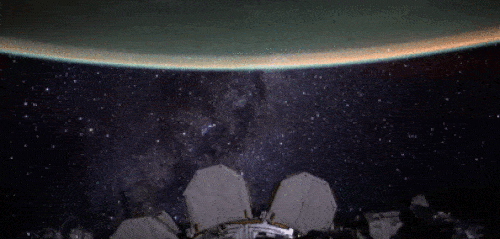
The International Space Station is an important and special place that is built on international cooperation and partnership. The station is a convergence of science, technology and human innovation that benefits and advances our global community here on Earth.

While the space station is an important aspect of our low-Earth orbit exploration, it is also the key to our next giant leap to deep space and our Journey to Mars. For example, our recent VEGGIE experiment aboard the space station is a critical aspect of long-duration exploration missions farther into the solar system. Food grown in space will be a resource for crew members that can provide them will essential vitamins and nutrients that will help enable deep space pioneering.
Another important experiment underway is the Twins Study that involves twin astronauts Scott and Mark Kelly. These investigations will provide insight into the subtle effects and changes that may occur in spaceflight as compared to Earth by studying two individuals who have the same genetics, but are in different environments for one year. You can follow Scott Kelly as he spends a year in space.
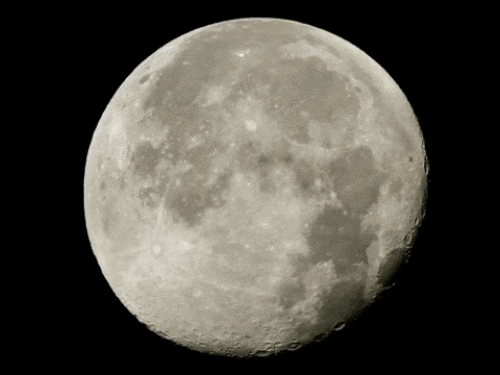
The space station is the second brightest object in the sky (after the moon, of course), and you don’t even need a telescope to see it! We can even tell you exactly when and where to look up to Spot the Station in your area!
So, as you look to spot the station in the sky, remember that even though it may look small from Earth, the crew onboard (and at home) are making contributions to international partnerships and global research.
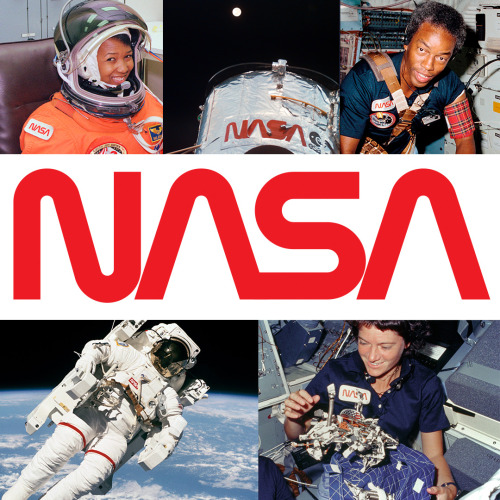
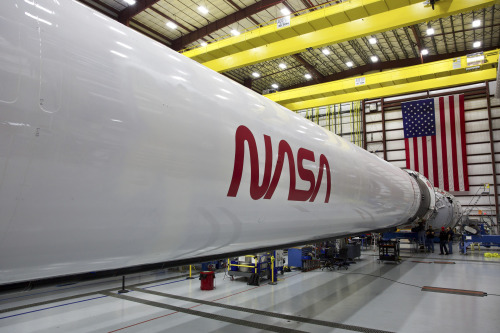
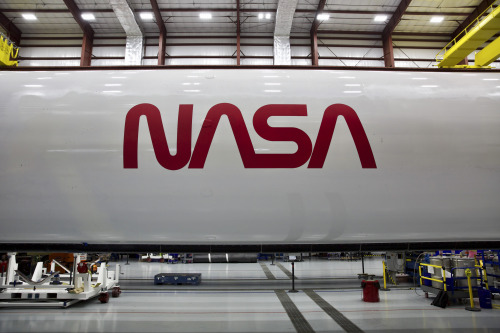
Retro. Modern. Iconic. That’s the worm.
#TheWormIsBack
Our beloved symbol of exploration will fly once again, just in time to mark the return of human spaceflight on American rockets from American soil. The retired logo is making its comeback on on SpaceX’s Falcon 9 rocket that will take flight later this year when we #LaunchAmerica once again.
The NASA insignia, or "meatball," seen in our profile image, was quite difficult to reproduce with 1970s technology. In 1975, enter the sleek, simple design you see above! The world knew it as “the worm.” For a period of time we were able to thrive with both the worm and the meatball. However, in 1992, the 1970s brand was retired - except on clothing and other souvenir items - in favor of the original late 1950s graphic.
Image Credit: NASA/SpaceX
Make sure to follow us on Tumblr for your regular dose of space: http://nasa.tumblr.com.
One Year Later
On March 1, 2016, veteran astronaut Scott Kelly returned from his Year in Space mission. In many ways, the adventure was just beginning.

The spaceflight part of the One Year Misson to the International Space Station ended a year ago today, but the science behind it is still moving. Astronaut Scott Kelly and Russian cosmonaut Mikhail Kornienko continue to provide samples for the data collection from their ground-breaking mission. Results are expected to to start coming later in 2017, which will help launch humanity on deep space missions.

Kelly not only commanded the International Space Station’s Expedition 46, he participated in spacewalks like this one on Dec. 21, 2015, in which Kelly and astronaut Tim Kopra successfully moved the Space Station's mobile transporter rail car ahead of the docking of a Russian cargo supply spacecraft.

On the station in 2015, Kelly showed off his home away from home. Scott tweeted this image out with the comment: "My #bedroom aboard #ISS. All the comforts of #home. Well, most of them. #YearInSpace."
Why was the Year In Space important? As we work to extend our reach beyond low-Earth orbit, how the human body reacts to microgravity for extended periods is of paramount importance. Not only were Kelly and his Russian counterpart monitored throughout the mission, they both continue to submit to tests and monitoring one year later to see if there are any lasting effects from their voyage aboard the station.
Scott Kelly also a human control here on Earth, his identical twin brother and fellow astronaut Mark Kelly. Both brothers have served aboard the International Space Station, but Scott’s stay was almost twice as long as typical U.S. missions. The continuing investigations are yielding beneficial knowledge on the medical, psychological and biomedical challenges faced by astronauts during long-duration spaceflight.
-
 magewaywardtocolover liked this · 10 months ago
magewaywardtocolover liked this · 10 months ago -
 iglooruins liked this · 1 year ago
iglooruins liked this · 1 year ago -
 angelnightingale777 liked this · 1 year ago
angelnightingale777 liked this · 1 year ago -
 transparentsoulfox liked this · 1 year ago
transparentsoulfox liked this · 1 year ago -
 moharoon liked this · 3 years ago
moharoon liked this · 3 years ago -
 hjrosner liked this · 3 years ago
hjrosner liked this · 3 years ago -
 whocaresifwearecrazy liked this · 3 years ago
whocaresifwearecrazy liked this · 3 years ago -
 naoseven liked this · 3 years ago
naoseven liked this · 3 years ago -
 blitzthefox liked this · 3 years ago
blitzthefox liked this · 3 years ago -
 jazzwazzmatazz liked this · 3 years ago
jazzwazzmatazz liked this · 3 years ago -
 mortenone liked this · 3 years ago
mortenone liked this · 3 years ago -
 wwsaber liked this · 3 years ago
wwsaber liked this · 3 years ago -
 2reputationpegacorns liked this · 3 years ago
2reputationpegacorns liked this · 3 years ago -
 hannedle liked this · 3 years ago
hannedle liked this · 3 years ago -
 greatscienceartangel liked this · 4 years ago
greatscienceartangel liked this · 4 years ago -
 sulestarlight liked this · 4 years ago
sulestarlight liked this · 4 years ago -
 catpeaks liked this · 4 years ago
catpeaks liked this · 4 years ago -
 enderfae liked this · 4 years ago
enderfae liked this · 4 years ago -
 batteurdurecyclage liked this · 4 years ago
batteurdurecyclage liked this · 4 years ago -
 maxinenextdoor liked this · 4 years ago
maxinenextdoor liked this · 4 years ago -
 glorisbellex liked this · 4 years ago
glorisbellex liked this · 4 years ago -
 mightiest-anathema liked this · 4 years ago
mightiest-anathema liked this · 4 years ago -
 transparentmakerdiplomatlan-blog liked this · 4 years ago
transparentmakerdiplomatlan-blog liked this · 4 years ago -
 ultimatemomfan reblogged this · 4 years ago
ultimatemomfan reblogged this · 4 years ago -
 infamousf liked this · 4 years ago
infamousf liked this · 4 years ago -
 colur-blue liked this · 4 years ago
colur-blue liked this · 4 years ago -
 lachrymoseworld liked this · 4 years ago
lachrymoseworld liked this · 4 years ago -
 divinity-infinity liked this · 4 years ago
divinity-infinity liked this · 4 years ago -
 princessoferebor94 liked this · 4 years ago
princessoferebor94 liked this · 4 years ago -
 oh-whaaaaat liked this · 4 years ago
oh-whaaaaat liked this · 4 years ago -
 aguapuracon liked this · 4 years ago
aguapuracon liked this · 4 years ago -
 baby--anais liked this · 4 years ago
baby--anais liked this · 4 years ago -
 idontknowhow2namethisshit liked this · 4 years ago
idontknowhow2namethisshit liked this · 4 years ago -
 grandbelievertriumph liked this · 4 years ago
grandbelievertriumph liked this · 4 years ago -
 burnt0ut liked this · 4 years ago
burnt0ut liked this · 4 years ago
Explore the universe and discover our home planet with the official NASA Tumblr account
1K posts